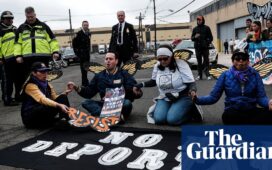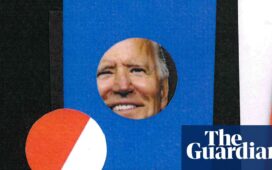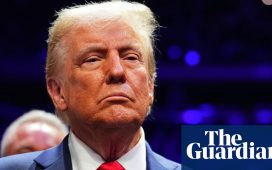The harrowing journey Nou Vang Thao took to freedom was nearly over when a boat captain gave Thao and his cousin three options: take their chances swimming to Thailand through the hazardous Mekong River, take the boat back to Laos or give him all the money they had.
It was 1975 and Laos was no longer safe for Thao and his fellow members of the Hmong ethnic minority.
“I almost got killed before I got freedom,” Thao explained from his home in Wausau, Wisconsin – nearly 8,000 miles away and 44 years after he made his escape.
The CIA armed a clandestine army of more than 40,000 in Laos, mostly Hmong, to fight communists in south-east Asia during the Vietnam war, in which the US dropped 2 million bombs on Laos – the most heavily bombed country per capita in history. When American forces left, the Hmong and their families were still in danger.
Thao, then 17, couldn’t go back. He had been armed with an American weapon as a child and had already survived two confrontations with communist soldiers who aimed their guns at him, but resisted pulling the trigger. So on that boat, nearing freedom in Thailand, Thao pulled out the last bits of money he had secreted away in his shoe – emptying his pockets for a future he couldn’t imagine.
It was the US that plucked him out of a refugee camp in Thailand and resettled him in Wausau, Wisconsin, a small city nestled between tracts of midwest farmland that was one of the whitest cities in the country when he first arrived.

Thao and 299,000 other Hmong are able to call the US home because of the refugee resettlement program, which is facing an unprecedented attack by Donald Trump’s administration.
Trump has shrunk the refugee program to the smallest resettlement numbers in decades – 22,000 people are expected to be resettled at the end of the fiscal year in September, 74% down from the 84,995 refugees resettled in 2016. This means fewer slots for today’s Hmong equivalents – including Iraqis who aided the US military and Kurds who aided American troops fighting Islamic State in Syria.
As the Trump administration attempts to dismantle the program, Wausau is a microcosm of the challenges and opportunities that come from the long policy welcoming refugees as new Americans.
The US resettled about 90% of the Hmong made refugees by the war, mostly in California, Minnesota and Wisconsin. Wausau is 9.1% Hmong, according to the 2010 US census – the highest percentage of any city in Wisconsin. The rest of the city is 83.7% white and a mix of other races.
There are Hmong-owned supermarkets that sell freshly made tofu and steamed rice cakes and restaurants that serve pork rice noodle soup and egg rolls. Hmong people own and work in businesses including factories, hotels and home-care centers across the 134,000-person metropolitan area. They teach at schools, hold elected office and run churches.

While the direct economic impact of Hmong has not been calculated, they are part of a wave of Asian immigrants that have boosted Wisconsin’s slow population growth and fed its economy.
In Wisconsin, the Asian-born population, which includes immigrants who are not refugees, contributed $88.6m in taxes to the federal, state and local government in 2014, according to a report by New American Economy, a coalition of business leaders.
Thao was one of the first Hmong to arrive in Wausau. When he arrived on 9 April 1976, he spoke almost no English. He quickly learned to not look around when he walked in town because at every stop light he was greeted by a middle finger – the beginning of a string of racist experiences that continues today.
In general, people have been kind and supportive over the decades, Thao said. He remembers fondly the church that resettled him bringing clothes from the Salvation Army and the people who he made friends with in school in the few short months he was there.
But once the subject of racism is broached, story after story pours out. There was the first few years, when he was constantly harassed on the streets. There was a job where he was called a “yellow [N-word]” every day until he quit.
When he hunts, he only uses a bow and arrows to avoid projecting aggression by using a gun. He still gets shouted at by men armed with guns and bows.

There is also the time, about 30 years ago, when he was fishing with his two sons who were about seven or eight and a white man drove his boat in circles around theirs, causing it to rock and threatening it to tip over. When he went to report the incident on the dock, the boat driver’s friend was there to hang up the phone every time he made the call, while holding a knife.
“It’s only one bad person, it’s not a community,” Thao explained. And he said the day-to-day racism dropped significantly as the Hmong population grew.
Today it’s the more subtle forms of racism young Hmong in Wausau see as a top concern, such as getting more Hmong in leadership roles in business and politics, and having them be respected when they get there.
City council member Mary Thao, who is related to Nou Vang Thao, said she gets requests every day from people trying to hire Hmong workers, but never in leadership roles. “We’re being sought out for being laborers in production and doing manual, hard work for cheap labor,” Mary Thao said.
Mary Thao, 41, was elected to city council in April 2018, replacing a woman who decided not to run for re-election after an email she sent to Mary Thao comparing a Hmong peace march to a Ku Klux Klan rally was made public.
Mary Thao said she experiences discrimination because she is the only non-white board member. “I’m not a puppet that you can just say, ‘Oh yeah we got a Hmong woman on the council or on the board and you know we embrace diversity and this is great for us,’ and then completely dismiss her,” she said.

While young Hmong such as Thao fight to improve representation, they are also confronting generational gaps between their culture’s traditions and their lives in the US.
From young professionals to teenagers at local high school, American-born Hmong shared concerns that the sacrifices made by Hmong elders have faded in the background, destined to be lost as fewer and fewer youth learn Hmong.
Lada Xiong-Vang, 36, has been fighting to improve professional outcomes for Hmong in Wausau at the Central Wisconsin Hmong Professionals (CWHP), which hosts networking events and skill-building classes, while also representing Hmong professionals in community forums. Thao is also an adviser there.
Xiong-Vang said in the past five years, she has felt acutely her own distance from the culture.
After spending much of her youth rebelling against Hmong traditions, she said she has only a loose grasp on the language and on how to properly prepare food. She worries lately about how this affects her young children, who are five and three.

Xiong-Vang’s parents met in a refugee camp in Thailand and she was raised in a traditional Hmong household. Her dad was a teenager when he crossed the jungle to the Mekong River during the monsoon season, fashioning shoes out of tires for the journey and communicating with a band of other travelers using only bird sounds to evade the communists. Her mother was younger and remembers less of the journey, but traveled with a group of soldiers in marginally less dangerous conditions.
“I believe that there’s a lot of value and richness in knowing your history and being able to share that and being grateful for that as to why your life is the way it is and to push you to work harder,” Xiong-Vang said.
Speaking in the history classroom of a local high school, Hmong teenagers in Wausau said they felt pressure from their parents and older relatives to maintain traditions that seemed outdated to them while also rebelling against the idea that they had to marry in their ethnic group or fulfill traditional gender roles.
Pa’Nyiag Lee, 16, and Alexander Cha, 17, said they found it difficult at times to figure out where they actually fit in. Their older, Hmong-speaking relatives would accuse them of being of whitewashed, and so would their peers who had better language skills.

“I didn’t feel that I belonged in any place,” Lee said.
Cha recalled that when he was a child, elders would criticize him for being chubby in Hmong. He was able to understand a couple of words, but when he asked what they were saying, he said, they responded in Hmong: “Don’t you know you are Hmong.”
As Hmong grapple with how to preserve their culture, an unlikely ally has persisted for decades in Wausau.
Jim Harris was a principal at Weston elementary school in the 1970s when he first learned about the Hmong. He was shocked by the stories Hmong students told him about dodging bullets in jungles and living in refugee camps. He remembered how at the time, Wausau residents talked about how they couldn’t find a “Hmong-land” on the map and pronounced the silent H in the name – a mistake that would never happen now.
The plight of people who remain in Laos became a slight obsession for him and he has visited the country 21 times in the past 20 years. Lately, these have been annual trips of three months to detonate some of the 30% of US ordnance that didn’t explode during the war and poses a daily threat to residents.

Harris had a huge collection of traditional clothing, bomb shrapnel and handmade goods from the trips to Laos, and in 2016 decided to house them in a museum that celebrates the refugee experience of all people from Laos, not just the Hmong.
Harris said the museum was partially a response to “the poisonous atmosphere” after the 2016 election.
“We were very disappointed to hear the anti-refugee, anti-immigrant comments,” Harris said. “In no way did it reflect the majority opinion, but it was disheartening.”
So, he and his wife, Marty, went to work. They rent a space in the local mall which had previously been a record shop and used their skills as educators to build a museum of a quality more than the sum of its parts. They bought $129 storm doors to use as displays for traditional clothing and used piping to build tables for displaying Laos insects and materials made of recycled ordinance.
On a Thursday night in May, the museum was open after normal hours, its bomb detonation videos blaring and bright lights spotlighting the displays. Most shops in Wausau were about to close, but a young Hmong couple happened to be in the mall and visited with a sleeping infant in a stroller. They had been to the museum before but still went through the displays, searching for names relevant to their personal history.

Resettling refugees is not a simple matter of deciding to house people and getting them out of a dangerous situation. The most difficult way to enter the US is as a refugee – the vetting process takes on average two years and there are currently 2.4 million refugees seeking safety. To escape Laos, the Hmong first had to get to refugee camps in Thailand.
In the US, the Hmong faced a new landscape dominated by farmland and snowy winters instead of the evergreen forestof their old homeland. They had to learn English and find jobs. While many refugees rely on government assistance in their first years to pay for food, healthcare and education, they also worked hard to repay the US, often driven to overcome the stereotype that they are taking advantage of the country that has given them so much.
Thao, now 60, summarized his experience in Wausau from his living room, which is decorated with seven deer heads, family photos and an award certificate for his military service from the state of California: “We come, we have nothing, now we have something.”








